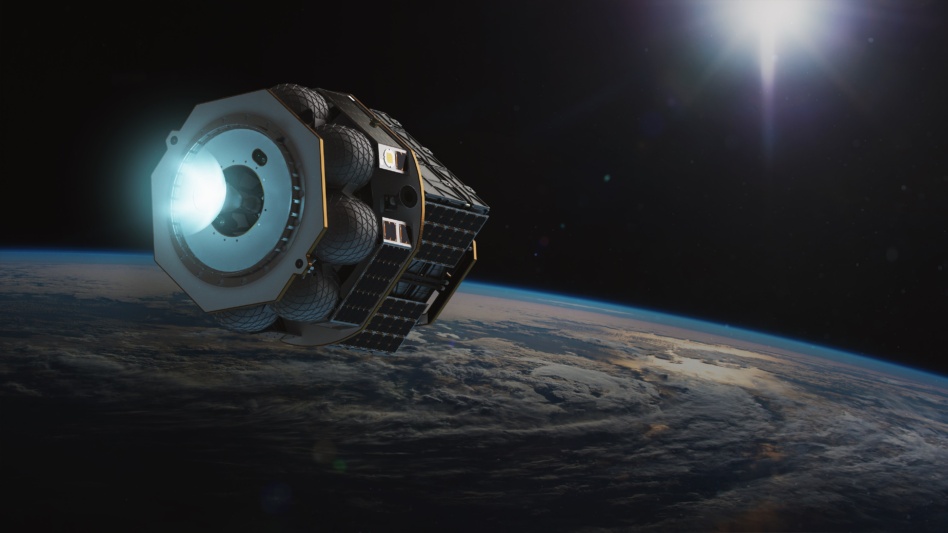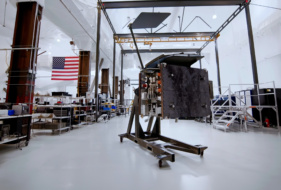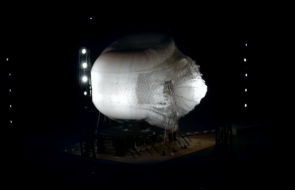For the first orbital launch of 2023, SpaceX’s Transporter-6 mission launched 114 small satellites into orbit. The spacecraft on the manifest ranged from cubesats to hosted payloads to orbital transfer vehicles (OTVs).
The Transporter satellite rideshare missions increasingly remind us of nesting dolls, as they launch space vehicles that in turn deploy even more space vehicles.
Here’s a rundown of most of the payloads that launched on Tuesday’s Transporter-6 mission. This story will be continuously updated with new information as it’s shared.
Earth observation
Umbra launched two microsats and France’s Unseenlabs launched its latest RF-detecting, ship-tracking satellite (with Exolaunch tackling deployment duties). ICEye sent its latest three satellites to LEO; Spire launched six LEMUR satellites; and Satellogic launched four satellites, growing its constellation to 30. Finally, Planet launched Flock 4y, consisting of 36 satellites that will replenish the SF company’s ~200-satellite, fully deployed fleet.
PS…fun fact from Umbra’s Joe Morrison:
Sovereign EO: As TerraWatch Space’s Aravind Ravichandran noted, a number of governmental entities launched their own satellites (or birds they procured off-the-shelf from commercial providers) on Transporter-6:
Space tugs
Italy’s D-Orbit flew two ION satellite carriers on the mission (for further reading, see the “Second Star to the Right” section below.)
Momentus, meanwhile, is flying an upgraded version of its orbital transfer vehicle (OTV). Vigoride-5 is deploying a satellite for Qosmosys and hosting a Caltech payload. That payload, SSPD-1, seeks to test wireless power transmission technology.
Orbiter SN1, a space tug and hosted payload platform from Hawthorne, CA-based Launcher, deployed with payloads from eight customers on board. SN1’s manifest included payloads from Innova Space, Logitech Mevo, Alba Orbital, Beyond Burials, NPC Space, TRL11, Bronco Space (from Cal Poly Pomona), and the Stanford Student Space Initiative. “This milestone will be five years ahead of our original ten-year plan to reach orbit and revenue,” Launcher CEO Max Haot said on LinkedIn, “thanks to SpaceX rideshare’s existence.”
Last but not least…Epic Aerospace, a chemical space tug startup, launched its first Chimera spacecraft. The tug runs on non-toxic, hypergolic propellants.
Firsts on orbit
Launcher and Epic are far from the only ones that hitched a ride to orbit for the first time on Transporter-6 orbit.
Magdrive, a startup developing electric plasma thrusters, is launching its first in-orbit demonstration. EOS Data Analytics, a geospatial company, launched EOS-SAT, its first satellite, on Transporter-6. The company plans to deploy an “agri-focused” constellation of seven optical satellites into LEO by 2025. For more, check out EOSDA and Space.com’s YouTube livestream of the Transporter-6 mission:
Orbital Astronautics (or OrbAstro) launched Guardian-alpha, a multispectral satellite. The Guardian is carrying a payload from Aistech Space that will collect data that can be used for wildfire prevention and mitigation.
A quick peek at other spacecraft launched on Transporter-6
Lynk deployed Tower 3 and 4 to continue the buildout of its satellite-to-phone network; Sony launched Star Sphere-1, which can take images and record 4K video with a full-frame sensor; and Canberra-based Skykraft launched five satellites aimed at closing gaps in Australia’s air traffic management.
Spaceflight helped Kleos launch four cubesats that will fly in formation and collect geolocation data. Digantara launched Pushan-Alpha, its second satellite, which will serve as a space weather testbed. Finally, Loft Orbital’s YAM-5 hosts a number of customer payloads, enabling a variety of use cases.
Spire’s sat stack
On Transporter-6, Spire launched:
- Two multipurpose satellites carrying next-gen Automatic Dependent Surveillance-Broadcast (ADS-B) payloads and onboard propulsion (a first for Spire). These satellites also include payloads for Myriota, an IoT provider, procured through Spire Space Services.
- One satellite affixed with a polarimetric radio occultation (PRO) payload. The payload was designed with support from ESA’s InCubed program, and will collect precipitation profile/pattern data.
- Three replenishments for Spire’s fully deployed, 100+ satellite fleet.
D-Orbit’s “Second Star to the Right”
The Italian space logistics firm’s two vehicles—SCV007 (Glorious Gratia) and SCV-008 (Fierce Franciscus)—will deploy:
- FUTURA-1, a 3U satellite, and FUTURA-3, a 6U satellite, for NPC Spacemind
- Four 5-kg Astrocast cubesats
- SHARJA-SAT-1, made by Sharjah Academy for Astronomy, Space Sciences (SAASST)
- TAUSAT2, manufactured by Tel Aviv University
- Kelpie 1, built by AAC Clyde Space and carrying an AIS monitoring payload.
Glorious Gratia and Fierce Franciscus also include the following third-party hosted payloads:
- DRAGO-2: a short wave infrared camera developed by the Instituto de Astrofísica de Canarias
- A new space propulsion system developed by Genergo
- Cryptosat-2, a next-gen prototype nanosat developed by Cryptosat that’s designed to power blockchain and cryptography missions
New SSC demo
Space Systems Command launched its Electro-optical/Infrared Weather Systems (EWS) demo cubesat. The satellite will test a new radiometric imaging sensor to provide speedier transmission of weather data from LEO. With a mission lifetime of one year, EWS satisfies a Congressional mandate to launch a weather pathfinder prototype by FY 2023.
Want to really get into the weeds?
Okay, great. Here are the smallsats and spacecraft in deployment order (via SpaceX):
- KuwaitSat-1
- BDSat-2
- SharedSat 2211
- LEMUR 2 EMMACULATE
- LEMUR 2 FUENTETAJA-01
- ConnectaT1.2
- GAMA Alpha
- BRO-8
- Menut
- Huygens
- LEMUR 2 DISCLAIMER
- STAR VIBE
- LEMUR 2 STEVEALBERS
- ISILAUNCH Kleos KSF3-A
- Birkeland
- SPACEBEE-156
- LEMUR 2 MMOLO
- ISILAUNCH Kleos KSF3-B
- ISILAUNCH Kleos KSF3-C
- LEMUR 2 PHILARI
- ISILAUNCH Kleos KSF3-D
- First Flock 4Y
- EWS RROCI
- SpaceBD ISILAUNCH PolyItan from Kiev
- Second Flock 4Y
- Guardian-alpha
- Third Flock 4Y deploys
- Fourth Flock 4Y
- SpaceBD Sony Sphere-1 EYE
- ISILAUNCH ClydeSpace NSLSat-2
- ISILAUNCH Sternula-1
- Fifth Flock 4Y
- Sixth Flock 4Y
- Seventh Flock 4Y
- Eighth Flock 4Y
- Ninth Flock 4Y
- 10th Flock 4Y
- 11th Flock 4Y
- 12th Flock 4Y
- 13th Flock 4Y
- 14th Flock 4Y
- 15th Flock 4Y
- 16th Flock 4Y
- 17th Flock 4Y
- 18th Flock 4Y
- 19th Flock 4Y
- 20th Flock 4Y
- 21st Flock 4Y
- 22nd Flock 4Y
- 23rd Flock 4Y
- 24th Flock 4Y
- 25th Flock 4Y
- 26th Flock 4Y
- 27th Flock 4Y
- 28th Flock 4Y
- 29th Flock 4Y
- 30th Flock 4Y
- 31st Flock 4Y
- 32nd Flock 4Y
- 33rd Flock 4Y
- 34th Flock 4Y
- 35th Flock 4Y
- 36th Flock 4Y
- Lynk Tower 3
- Albania 1
- Lynk Tower 4
- YAM-5
- NewSat 34
- Albania 2
- X22
- X21
- First Umbra
- Second Umbra
- NewSat 35
- ION SCV-007 GLORIOUS GRATIA
- ION SCV-008 FIERCE FRANCISCUS
- Launcher Orbiter SN1
- X27
- Skykraft 1
- Vigoride 5
- CHIMERA LEO 1
- EOS SAT-1
It’s a vibe
As we’ve written before on Transporter launch days, if you glanced at any space-focused Twitter or LinkedIn feeds yesterday, you could feel it in the air. Starfish Space’s Michael Madrid sums it up best:




